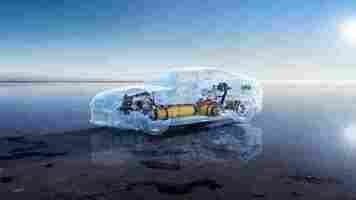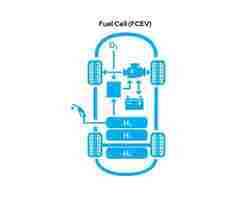3 important mobility tech trends from CES2021
CES went digital for obvious reasons this year. I missed the serendipity associated with strolling up and down alleys of startups and wandering around corporate booths. It was much more difficult to feed my curiosity and discover unexpected products, services, materials, partnerships, or old friends, all online. However, I did not miss having achy feet at the end of the day! All in all, I missed the live version.

After reporting on mobility and autotech at previous CES exhibitions ( 2017 , 2018 , 2019 , 2020 ), I am happy to share what drew my attention this year. The unique format attracted fewer than half of last year’s exhibitors, i 1960 vs 4500. The largest cohorts came from the USA (569), Korea (341), China (203), and France (135). Whereas 170,000 people attended last year, I assume more people were able to take part this year, which is a good thing. The digital venue will remain accessible until February 15 for content viewing.
This year’s main mobility/autotech topics were digital cockpit and in-cabin experience, electrification, and autonomous driving, although to a lesser extent.
Digital cockpit and in-cabin experience
The best illustration of the digital cockpit trend came from Daimler. The immersive MBUX Hyperscreen, which will be first featured on the Mercedes EQS, will certainly give Tesla Model S’ 17-inch center display and Porsche Taycan’s 4-display set-up a run for their money. The 56-inch single, curved piece of glass almost runs pillar-to-pillar and hosts specific OLED displays zone in front of the driver, as well as the front passenger and in the center. Perceived quality seems amazing ( video ).
An 8-core CPU will control drive and comfort features with the assistance of AI. The “co-driver display” offers a broad array of options and the ability to share content with rear passengers. For safety reasons, this display will apparently be deactivated if the driver peeks at it, thanks to a camera that monitors their eye gaze.
Augmented Reality associated with a Head-Up Display (HUD) also made the show, after being introduced on VW’s recently launched ID.3 . Panasonic presented its own version . In both cases, computer vision and object classification are combined with navigation input and the HUD to project guidance and safety-critical information in front of the driver. The decreasing cost of HUDs, the increasing availability of the raw data, and computing power should make this feature almost ubiquitous in a few years.
Electrification
Sony surprised us last year when they introduced Vision-S Concept, a battery-electric sedan that leverages the company’s broad range of tech. If most people had any doubts as to Sony’s real intentions, this should no longer be the case. The company doubled down , showing road testing as well as presenting their partners. These include Magna Steyr, Bosch, Valeo, Continental, ZF, Vodafone, HERE, AIMotive, and more. It is surprising that all the suppliers are European.
This recent announcement demonstrates Sony’s serious resolve. Could this new outlook make the brand cool again? It comes within weeks of comparable news or rumors regarding other tech giants’ forays in the mobility space. This recent news and rumors related to Apple’s evasive Titan car project, Amazon’s Zoox robotaxi, Alibaba’s (China’s Amazon) Zhiji/IM EV JV with SAIC, or Microsoft’s participation in GM/Cruise’s $2B round.
These moves by powerful and rich tech companies add pressure on incumbent OEMs and suppliers. It forces them to accelerate their transformation towards electrification, digitalization, and mobility services. By the way, a centerpiece of Bosch’s press conference was its reorganization, bringing its 17,000 compute HW and SW resources in a new Cross Domain Computing Solutions unit. We should expect this to turn into a powerhouse.
On the electrification front, I would highlight the JV announced between Magna and LG Electronics to manufacture e-motors, inverters, on board chargers, and e-drive systems. LG will contribute their electrical/electronic capabilities, building on the experience acquired on the Chevy Bolt EV and Jaguar I-PACE, whereas Magna will bring their software, systems integration, and manufacturing expertise.
Autonomous Vehicles
There were fewer announcements on the autonomous driving front than in the last couple of years. Mass deployment of AVs is perhaps a decade away. Yet, a wave of concentration — the last sign being Aurora’s recent acquisition of Uber ATG — combined with massive funding rounds by the big players enables the latter to increase the pace of full driverless pilots by the likes of Waymo, Cruise, or AutoX.
During CES, Mobileye announced the development of a new LiDAR system-on-chip (SoC), leveraging the capability of its parent company Intel. With this product, which will be part of the company’s camera-first sensor suite, Mobileye anticipates they will have a Level 4 system at a cost compatible with broad consumer demand by 2025. In the meantime, the company will deploy AV pilots in Tokyo, Shanghai, and Paris besides its current cities (Tel Aviv, Munich, and Detroit). These deployments can reportedly happen in 2 weeks by 2 people.
Separately, GM announced they will deploy Super Cruise to 22 vehicles by 2023. Well-perceived on Cadillac CT6, the Level 2 solution will be used next on the CUV version of the Bolt EV. GM continues with its double paths to full autonomy, educating the public with the more widely distributed Level 2, and shooting straight to Level 4 with Cruise.
If you are interested in learning about CES 2021 beyond autotech and mobility, I recommend Olivier Ezratty’s CES report . It is as enjoyable as always even in this shorter version (in French).
This article was written by Marc Amblard, Founder & Managing Director, Orsay Consulting on The Urban Mobility Daily , the content site of the Urban Mobility Company, a Paris-based company which is moving the business of mobility forward through physical and virtual events and services. Join their community of 10K+ global mobility professionals by signing up for the Urban Mobility Weekly newsletter . Read the original article here and follow them on Linkedin and Twitter .
SHIFT is brought to you by Polestar. It’s time to accelerate the shift to sustainable mobility. That is why Polestar combines electric driving with cutting-edge design and thrilling performance. Find out how .
A closer look at how Buenos Aires plans to cut emissions in half by 2030
This article was originally published by Sarah Wray on Cities Today , the leading news platform on urban mobility and innovation, reaching an international audience of city leaders. For the latest updates follow Cities Today on Twitter , Facebook , LinkedIn , Instagram , and YouTube , or sign up for Cities Today News.

The City of Buenos Aires has published its Climate Action Plan 2050 , which sets out targeted measures to cut greenhouse gas emissions and increase resilience.
The Argentinian capital has pledged to become climate-neutral by 2050, reducing emissions 53 percent by 2030 and 84 percent by 2050.
The plan outlines 24 areas of action under four main pillars: preparedness; proximity to local amenities; adoption of low carbon policies and technologies; and inclusion.
Within this, the city is aiming for three-quarters of passengers to exclusively use public and non-motorized transport by 2030. By 2050, 80 percent of all residential buildings will be retrofitted according to strict energy-efficiency standards, and 70 percent of all new buildings will use solar thermal energy.
Horacio Rodriguez Larreta, Mayor of Buenos Aires, said: “We are at a crossroads in climate history where cities’ commitments to climate action and building resilience will be critical to our post-pandemic recovery and to the success of key international climate milestones.”
“Our Climate Action Plan reflects not only the importance we attach to tackling the global climate crisis and mitigating climate risks on our doorstep, but also our broader vision of continuing to build our city on a more human scale to prioritize public space, sustainability and quality of life,” he added.
Streets to meet
Other key measures include planting 100,000 more trees by 2025; implementing 15 new pedestrian zones by 2030; and ensuring all buses are zero emissions by 2050.
By 2025, the city says that every resident will be an average distance of 400 meters from a green space. It also plans to create a pedestrian street designated for community meetings and cultural events in every one of the city’s 48 neighborhoods.
The city will continue to expand cycle lanes and is aiming for 1 million daily journeys to be taken by bike by 2023.
All vulnerable neighborhoods should have vegetable gardens by 2025.
“Our commitment to climate action will also be key to attracting international talent and promoting economic development, supporting the transition to jobs of the future and generating new opportunities,” said Fernando Straface, Secretary General and Secretary for International Relations, City of Buenos Aires.
Straface recently told Cities Today how Buenos Aires plans to attract students, digital nomads and tourists again after the disruption caused by COVID-19.
Do EVs excite your electrons? Do ebikes get your wheels spinning? Do self-driving cars get you all charged up?
Then you need the weekly SHIFT newsletter in your life. Click here to sign up .
Are hydrogen fuel cells the future of green transport? Sorta
Around the world, governments are implementing policies to promote electric vehicles to reduce oil consumption, climate-related emissions and improve local air quality. Most of the attention is on plug-in electric vehicles.

But there’s another option, Hydrogen Fuel Cells (HFCs), an electrochemical power generator that combines hydrogen and oxygen to produce electricity, with water and heat as byproducts.
HFCs form energy that OEMs can use to power anything from commercial vehicles to forklifts and drones.
How do Hydrogen Fuel Cells work?


The hydrogen in the fuel tanks travels to the fuel-cell stack. Inside the stack, the hydrogen undergoes an electrochemical reaction with oxygen that’s collected through the air intake. This process generates electricity which either directly powers the motor or is stored in the battery for future use.
Hydrogen Fuel Cell vehicles are similar to electric vehicles (EVs) in that they use an electric motor instead of an internal combustion engine to power the wheels. However, while EVs run on batteries that rely on a plug-recharge, HFC vehicles generate their electricity onboard.
A HFC vehicle needs to be pumped up with hydrogen at a specialist filling station.
The value of HFC vehicles
As a form of energy, hydrogen fuel cells have a lot going for them:
An as element hydrogen is abundant.
Hydrogen can be used in rockets , ships, planes, cars, trucks, buses, and other vehicles and as an energy source to power buildings.
When fueled with pure hydrogen, HFC’s only byproducts are heat and water, making them a zero-emission sustainable power source.
Hydrogen fuel cells are generally between 40-60% energy efficient. A typical internal combustion engine of a car is about 25% energy efficient.
HFC vehicles are refilled with Hydrogen at refilling stations. Refilling takes about 3-5 minutes for over 300 miles of travel. Comparatively, a Tesla supercharger takes 15 minutes to recharge up to 200 miles, and other rapid chargers take at least 30 minutes to charge 80%.
Handled correctly, hydrogen is safer to use than conventional fossil fuels. If a leak occurs, lighter-than-air hydrogen gas rises and disperses rapidly. This non-toxic gas is also safe to breathe.
Hydrogen startups are abundant
There are well over 300 startups (many University offshoots) accelerating growth in green hydrogen and hydrogen fuel cells. Credit: Contrarian Ventures
Notable startups include:
Hypoint
H2Pro
Hytech Power
Hydra
Plug Power
myFC
There’s strong government and commercial commitment to HFCs. This will result in rapid growth in green hydrogen, hydrogen pipelines, broader use cases, and fuel cell innovation. Hydrogen fuel cells are not going anywhere fast.
Barriers to mainstream adoption
However, HFCs face significant barriers before mass adoption becomes a reality (if ever):
Extracting hydrogen from a water molecule is an energy-intensive process that generates greenhouse gas emissions if renewable energies are not used. Currently, less than 1% of hydrogen produced is green , but this is improving.
Hydrogen is expensive to transport to fueling stations.
While HFC vehicles need fewer public refueling stations than EVs, there aren’t all that many. However, their numbers are increasing .
Comparably, EV owners can charge their vehicles at home with the right setup.
There’s lots of failures, like truck startup Nikola , whose founder was indicted on charges of lying to investors and securities fraud, which included pushing a truck down a hill to pretend it was “fully operational.” Even at the 2021 Japan Olympics , which pledged to showcase the efficacy of Hydrogen, only a few buses on shorter routes used HFCs, and Hydrogen fuelled only one Olympic village.
Hydrogen Fuel Cell Electric Vehicles on the market now
Most OEMs have invested in HFC vehicles, with a number of releases over the last few years. Notable examples include:
BMW i Hydrogen NEXT
Honda FCX Clarity
Hyundai Nexo
Hyundai ix35 FCEV
Mercedes Benz F-Cell
Riversimple Rasa
Toyota Mirai
Long haul transport is the future of HFCs at least for now
Hydrogen fuel cells are being rolled out across numerous transport verticals, including trains , trucks , and buses . These industries are all pushing to reduce their carbon impact. For example, in the US, transit agencies are required to transition to a zero-emission bus fleet by 2040.
Hydrogen fuel cells can generate more power when pulling heavier loads uphill than an equivalent-sized lithium-ion battery and offer a greater range. Hyundai’s Xcient Fuel-Cell trucks feature a 190-kilowatt fuel cell comprised of seven high-pressure tanks holding around 35kg of hydrogen.
The trucks have a long-distance range of about 400km before refueling is required, which far surpasses the capabilities of vehicles powered by electric batteries. The fuel cell can be charged in under 20 minus and drive for about 250 miles before needing more hydrogen.
Hyundai is investing heavily in hydrogen, planning to put 1,600 hydrogen trucks on Swiss roads by 2025, and set to launch similar projects in other European countries. The company has been renting its trucks to local companies in Switzerland for almost a year.
But c’mon are HFCs a fool errand?
Elon Musk is not a fan of hydrogen fuel cells, calling them ”fool sells” and “ staggeringly dumb. ” It’s hardly surprising since the Tesla empire is built on lithium-ion batteries.
It’s worth noting that HFC technology is still in its early stages, unlike EVs. But even electric cars took decades to go mainstream.
The technology has a way to go, particularly in obtaining and transporting hydrogen. It’s years away from mainstream adoption, especially in cars. HFCs are not a threat to electric vehicles, and I don’t believe we’ll ever see adoption overtake electric cars.
However, HFCs will remain relevant, particularly in long-distance transport such as freight trucks and trains. Whatever your view, governments are heavily invested in HFCs. This provides an opportunity to accelerate innovation, and we can expect to see a greater range of improved product offerings, both in development and at market.